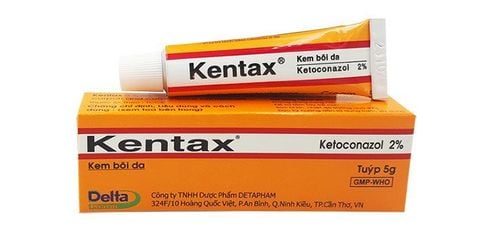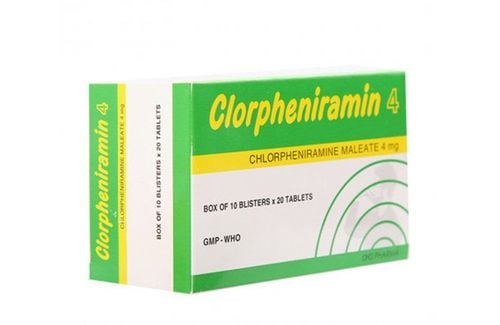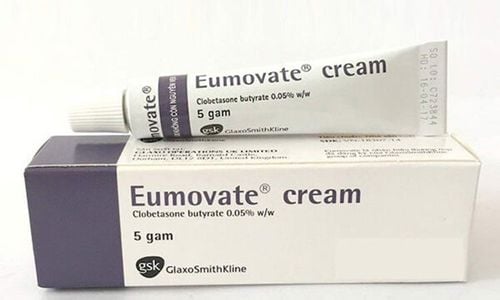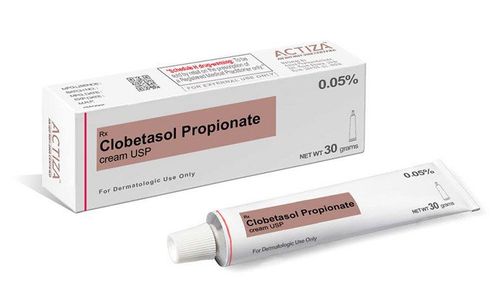This is an automatically translated article.
Gentriboston is commonly used to treat corticosteroid-responsive dermatitis when complicated by secondary infection. To use drugs safely and effectively, patients need a prescription and guidance from a doctor.
1. What is Gentriboston?
Gentriboston medicine contains the main ingredients are Clotrimazol, Betamethasone Dipropionate and Gentamicin.
The drug is prepared in the form of a topical cream with the following content:
Clotrimazol 100mg; Betamethasone dipropionate 6.4mg; Gentamicin (as Gentamicin sulfate) 10mg; Excipients are sufficient. Pharmacodynamics:
Clotrimazol is a synthetic imidazole derivative with antifungal activity. In vitro tests showed that clotrimazol had inhibitory and fungicidal effects depending on the concentration against strains of Trichophyton rubrum, Trichophyton mentagrophytes, Epidermophyton floccosum, Microsporum canis and Candida. Betamethasone dipropionate is a potent glucocorticoid that, when used topically, has anti-inflammatory, antipruritic, and vasodilating effects. Corticosteroids can bind to corticoid receptors in the cytoplasm, then cross the nuclear membrane and interact with DNA, thereby inducing the synthesis of lipocortin - a protein that inhibits the activity of the enzyme phospholipase A2 (PLA2). . PLA2 is an enzyme that hydrolyzes cellular phospholipid membranes and releases arachidonic acid, which is a precursor for the synthesis of inflammatory chemical mediators such as prostaglandins and leucotrienes. In addition, corticosteroids also reduce mast cell density, decrease chemotaxis and eosinophil activation, and decrease cytokine production by lymphocytes, monocytes, mast cells and eosinophils. Gentamicin sulfate is an aminoglycoside antibiotic with bactericidal effect by inhibiting bacterial protein synthesis. The bactericidal spectrum includes many strains of Gram-negative aerobic bacteria, such as: Brucella, Calymmatobacterium, Campylobacter, Citrobacter, Escherichia, Enterobacter, Francisella, Klebsiella, Proteus, Providencia, Pseudomonas, Serratia, Vibrio and Yersinia; Gram-positive bacteria such as Staphylococcus aureus are highly sensitive to gentamicin, Listeria monocytogenes and some strains of Staph.
Epidermidis are also still susceptible to gentamicin, but Enterococci and Streptococci are usually no longer susceptible. Some Actinomycetes and Mycoplasmas are sensitive to gentamicin but Mycobacteria are no longer clinically sensitive. Gentamicin is no longer active against anaerobic bacteria, yeasts and resistant fungi. Gentamicin has little effect on gonococcal, streptococcal, pneumococcal, meningococcal, Citrobacter, Providencia and Enterococci bacteria.
Obligate anaerobes such as Bacteroides, Clostridia are resistant to gentamicin. In Vietnam today, strains of E. Aerogenes, Klebsiella pneumoniae, and blue pus bacilli are resistant to gentamicin, but gentamicin is still active against H.influenzae, Shigella flexneri, Staphylococcus aureus, S. epidermidis, especially Staph . Saprophyticus, Salmonella typhi and E. coli.
Pharmacokinetics
Absorption: Under normal conditions, only a fraction of Betamethasone appears in the blood when applied topically. Clotrimazol is poorly absorbed when applied to the skin. Most of the drug is retained in the stratum corneum, only a small amount is absorbed into the bloodstream. The amount of drug present in plasma was below the detection limit (0.001 μg/ml), indicating that topical Clotrimazol is unlikely to result in any significant systemic or adverse effects. Gentamicin is not absorbed through the skin if used on intact skin. However, the drug can be absorbed systemically like other Aminoglycosides after topical application on abraded skin, burns, wounds and body cavities except the bladder and joints. Distribution: Betamethasone distributes rapidly into all tissues in your body. Gentamicin diffuses mainly into the extracellular fluid and readily diffuses into the inner ear fluid. No information is available on the distribution profile of clotrimazole after absorption. Metabolism: Betamethasone is a long-acting glucocorticoid with a half-life of about 36-54 hours and is metabolised in the liver. Gentamicin is not metabolized. Clotrimazole is absorbed and metabolised in the liver. Elimination: Betamethasone is eliminated primarily by the kidneys with a metabolic rate of less than 5%. Gentamicin is eliminated unchanged in the urine by glomerular filtration. Clotrimazole is excreted in the feces and urine.
2. What does Gentriboston do?
Effects of ingredients:
Clotrimazol: Synthetic Imidazol derivative, has antifungal activity against yeasts, molds and skin fungi. Mechanism of action: inhibits the synthesis of Ergosterol (an important component in the structure of fungal cell walls). Betamethasone dipropionate: Is a potent Glucocorticoid, anti-inflammatory, antipruritic and vasodilator. Mechanism of action inhibits PLA2 activity (enzymes that hydrolyze membranes of Phospholipids, release Arachidonic Acid, precursors to synthesize inflammatory chemical mediators). Simultaneously, decreased Mast cell density, decreased activation and chemotaxis of eosinophils, decreased Cytokine production. Gentamicin: Aminoglycoside antibiotic, has bactericidal activity, inhibits bacterial protein production. Gentriboston drug is used for the following cases:
Dermatitis with superinfection; Inflammatory skin lesions that respond to corticosteroids such as diaper rash, eczema, contact dermatitis, pruritus, psoriasis; Fungal diseases of the skin, scalp, dark skin, thigh skin with superinfection and inflammation.
3. Gentriboston side effects
The drug is easily tolerated and has few side effects. Mostly due to systemic absorption when drug abuse or misuse such as prolonged application, skin folds, more than prescribed. The risk is higher in infants and children.
Common: Local burning pain, itchy skin. Very rare: Inhibition of the hypothalamic-pituitary-adrenal axis, delayed weight gain in children, increased intraocular pressure, elevated blood glucose, Cushing's syndrome, decreased cortisol secretion, increased blood pressure, cataracts, erythema , hypersensitivity, accumulation of nephrotoxicity, ototoxicity when applied to open wounds, large areas, combined with other Aminoglycosides, striae, skin atrophy,... If you see any side effects, notify immediately to qualified doctor or pharmacist for prompt treatment.
4. Drug interactions
Several interactions have been reported, including:
Clotrimazol antagonism of action with Amphotericin, other Polyene antibiotics. It also increases serum concentrations of tacrolimus in liver transplant recipients. The dose should be adjusted accordingly. When used on the anal and genital area, it may reduce the contraceptive effectiveness of condoms. Another method of contraception should be used for at least 5 days after stopping the pill. To ensure safety and effectiveness, tell your doctor about all medications, health foods you are taking, and other illnesses you have.
5. How to use Gentriboston
How to use:
Apply only on the skin and apply the cream in a thin layer to the affected skin, 1-2 times a day. Wash your hands thoroughly before and after applying the medicine. Dosage:
For adults and children over 12 years old with dosage: Apply a thin layer of cream to cover the entire diseased skin and surrounding skin, regularly 2 times a day (morning, evening). The duration of treatment will vary depending on the results of the clinical examination, microbiological tests and the patient's response to treatment. In the case of mycosis of the foot: A longer course of treatment (from 2 to 4 weeks) should be considered. Children 2-12 years old: Apply a small amount to the affected area and massage gently. Use no more than 2 times in a day with an interval of at least 6-12 hours. It should only be used on the face, neck, scalp, genital area, rectal area, and skin folds under the care of a physician. The duration of treatment is limited to about 5-7 days. Note: The above dosage is for reference only. The specific dose depends on the condition and the progression of the disease. To get the right dose, you need to consult your doctor or healthcare professional.
Overdose:
Excessive application on the skin or long-term use can cause collagen loss of the skin and atrophy of the skin. In some cases, topical corticosteroids can be absorbed and cause systemic effects such as HPA axis suppression, secondary adrenal insufficiency, and manifestations of adrenocortical hyperfunction, including Cushing's syndrome. Excessive or prolonged use of Gentamicin or over large areas of skin may lead to overgrowth of non-susceptible microorganisms. Treatment:
Use appropriate symptomatic treatment. Treat electrolyte balance if necessary. In case of chronic poisoning, the drug should be discontinued gradually. If growth of non-susceptible organisms occurs, discontinue the drug and institute appropriate treatment. If you forget a dose, take it as soon as possible. However, if it is almost time for your next dose, skip the missed dose and take your next dose at the scheduled time. Note that double the prescribed dose should not be taken.
6. Be careful when using Gentriboston
Use in pregnant women and nursing mothers:
Pregnant women: the safety of the drug when used during pregnancy has not been established. Use only if prescribed by a doctor, weighing the benefits of treatment and the risk to the fetus. Lactation: It is not known whether the drug is sufficiently absorbed from the body to be excreted in breast milk. Consider discontinuing breast-feeding or discontinuing the drug. People who drive and operate machines:
No adverse reactions affecting the ability to drive and use machines have been reported. Store Gentriboston at a temperature below 30 degrees Celsius, away from direct light, out of reach of children. To ensure safety when using the drug, patients should consult their doctor before using.
Please dial HOTLINE for more information or register for an appointment HERE. Download MyVinmec app to make appointments faster and to manage your bookings easily.













